For some drivers, it’s the longest race they’ll never finish.
The Nurburgring 24 Hours pulls no punches when it comes to demands on minds and bodies. The twice-around-the-clock distance feels more like ten times if you haven’t slept. The already-narrow Nordschleife seems even tighter knowing that putting one tire wrong can spell instant disaster. Adding in multiple classes with vastly different speeds on that track makes it even more hectic.
And yes, there are physical demands, even from sitting in an office chair. It was this race two years ago that made me start wearing gloves while driving since I started to develop calluses and blisters on my hands from wrestling the car around the track.
Because of all of those factors, it’s the most difficult endurance race on iRacing. One mistake tends to snowball into more because of the limited margin for error and the mental toll of the Green Hell.
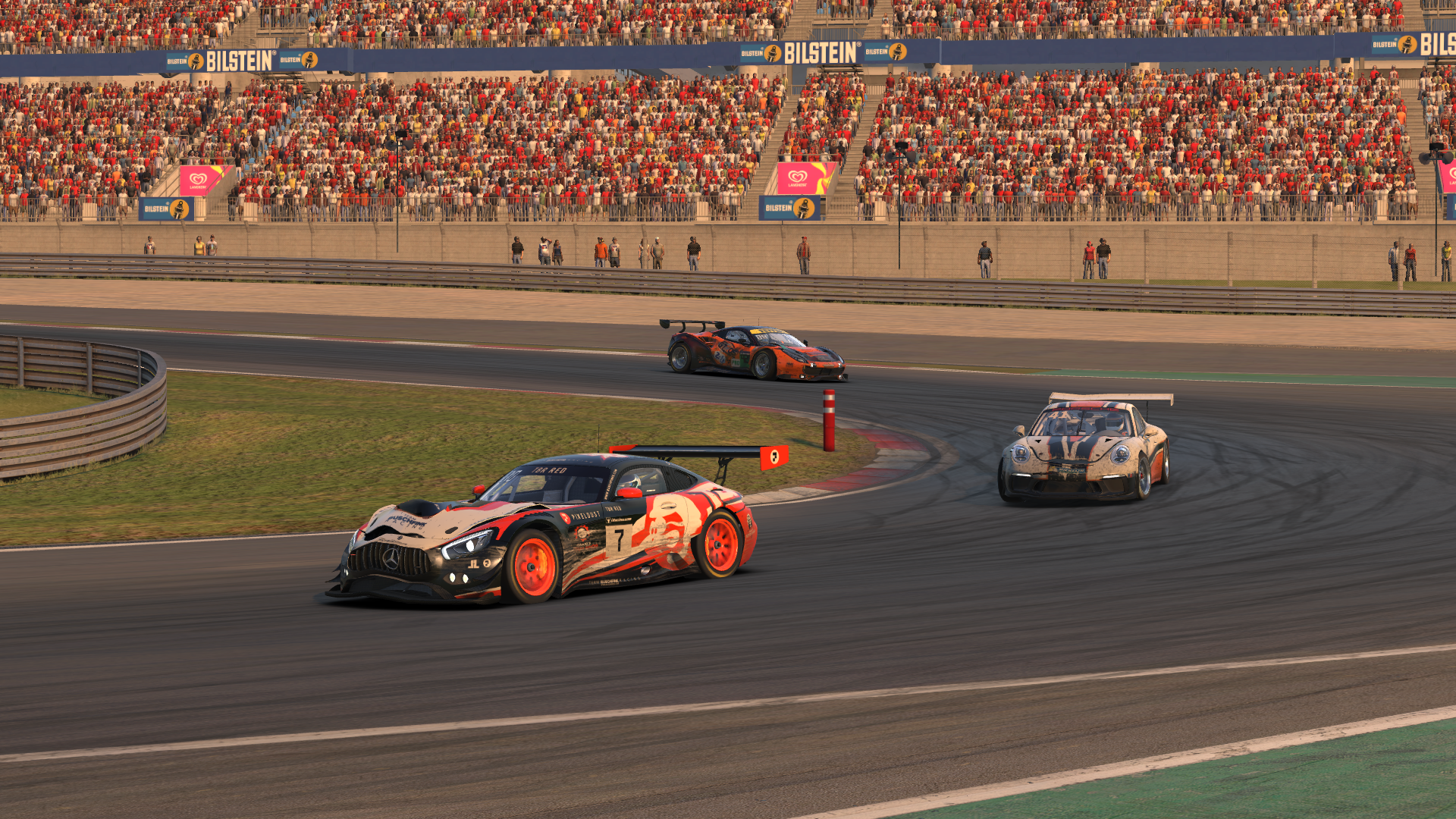
Racing into turn 1 among lapping GT3 traffic.
I’ve seen how quickly things can go wrong here. Last year’s race ended in the first corner for our SRN Motorsports car, as another Porsche clipped us and flipped our car — and our race — on its roof.
However, I have also reaped the rewards of a disciplined drive at the ‘Ring. In this event two years ago, my teammate Karl and I put in a herculean two-man effort en route to a class win. We had decent pace, but more importantly, we kept our car clean. As other teams dropped out, we built a big lead and could coast to the finish with several laps in hand over our competitors.
Leading up to that race, Karl and I already had several seasons of experience in the Ruf C-Spec, the store-brand cousin of the current Porsche 911 GT3 Cup car. In the weeks prior to the race, we put in hours of practice and more hours poring over telemetry, often taking turns setting new best sector times along the way as we collectively gained speed.
This year, my practice time was limited due to some travel in the weeks before the race, and while the Porsche is my favorite car on iRacing, I hadn’t driven it in months. That meant I’d have to go off instinct and whatever institutional knowledge I retained about the 150+ corners at the Nurburgring.
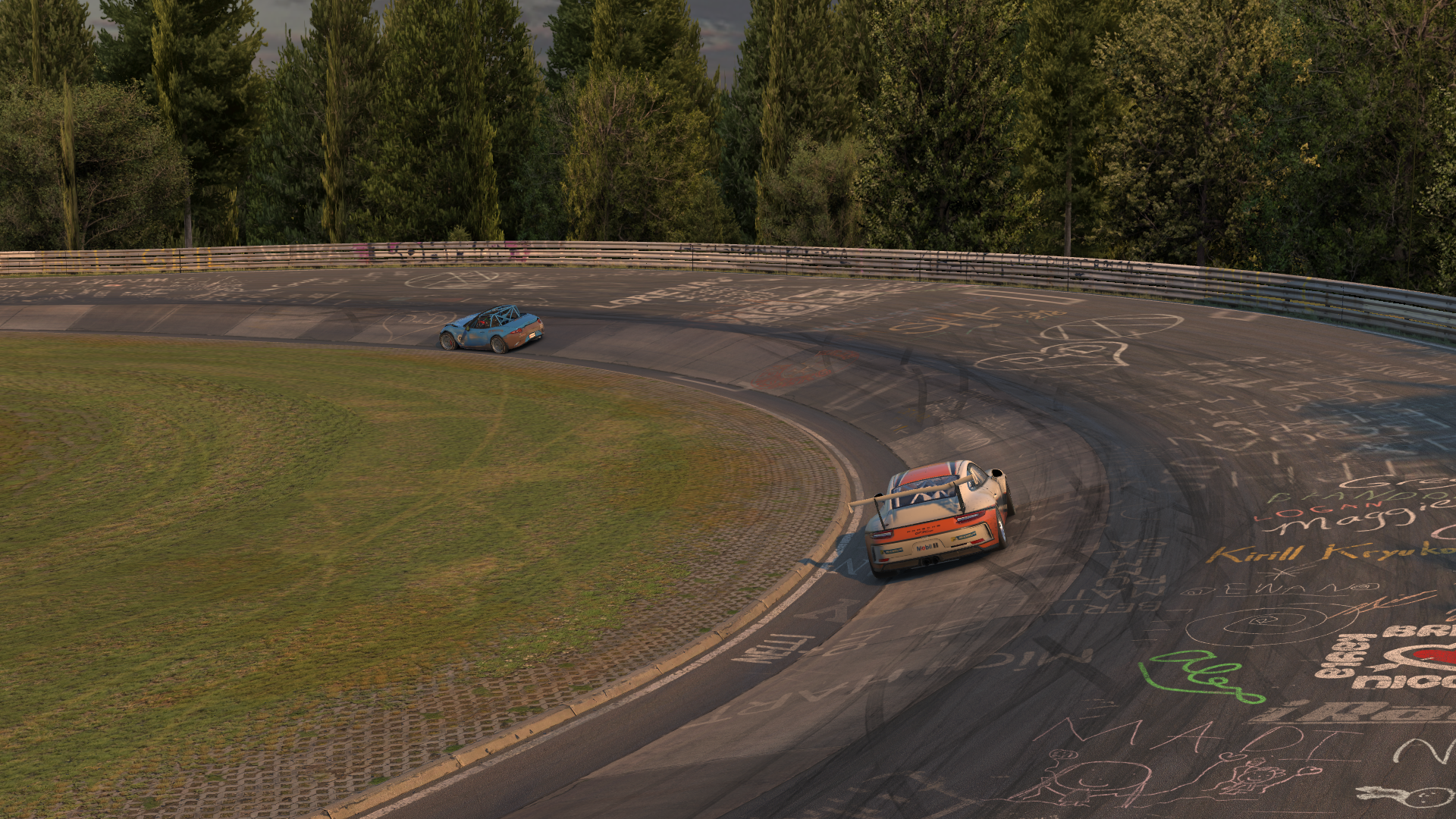
Chasing a Mazda through the Karussell — one of many dozens of corners at the ‘Ring.
When I started practicing, I found that some of that knowledge had become a fuzzy abstraction, especially about the twisty section from the Karussell through the Pflanzgarten complex. I remembered the order of the corners, but even in the C-Spec, it often felt like I was tiptoeing through there rather than extracting the best performance from the car, and from myself.
As I practiced more, the whole track started to come more naturally to me. It could have been the extra experience or the responsive feeling of the Porsche, which seems to take those twisty sections in stride. Of course, I was still well aware that screwing up any of those turns could ruin the whole team’s race.
Orange Crushed
Our car started ninth out of 18 Porsches, and we were joined on the grid by 20 GT3 cars and 14 Mazda MX-5s. When the green flag flew, I couldn’t help but wonder how many of those cars would be running after 24 hours. Would our’s?
We made it through turn one — an improvement over last year — and through the first half-hour without issue as our starting driver Steve began to pick off positions ahead of him.
However, the first trip through Mazda traffic brought a problem. The two Porsches ahead of us were side-by-side through some of those tight, twisty corners late in the lap as they tried to navigate the slow MX-5 pack. They made contact and spun out, blocking the track.
Steve made a snap decision to take to the grass to avoid them, but on the tractionless offroad surface, he also hit the outside wall. Early in the race, we had a bent rear wing and front-end damage that acted like a parachute, costing us 4 or 5 miles per hour in top speed.
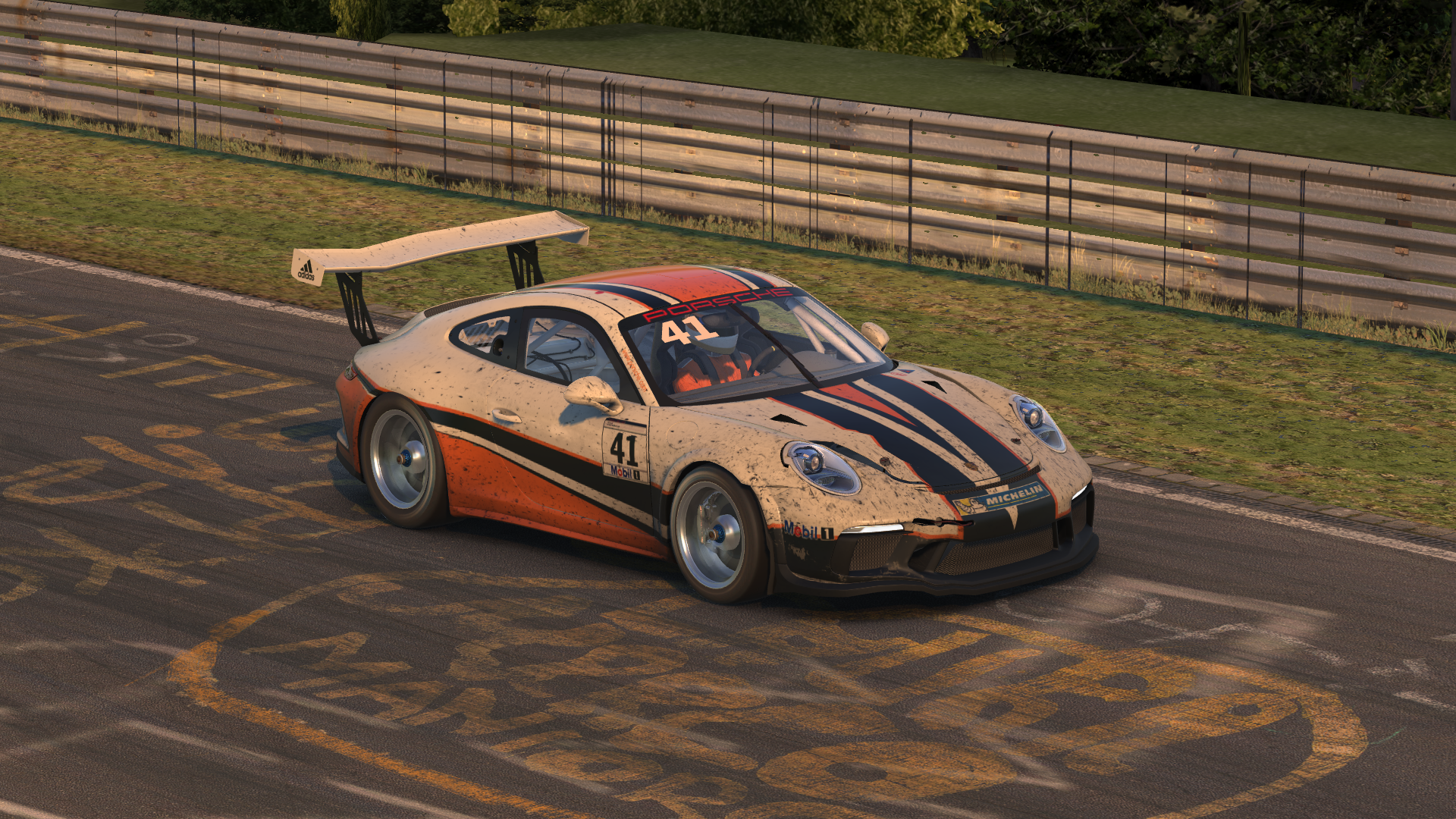
Our damaged car early in the race.
Like most of the Porsche field, we had planned to double-stint our tires, but at the first pit stop, we decided to change tires so we could also fix some damage. The repairs were slow — only about 10 seconds’ worth during a tire change — and it seemed like we had an uphill battle to get that damage fixed and stay in contention.
Over the next three hours, we suffered even more front-end damage as our second driver, Jason, ran a bit wide in one corner and nosed into the wall. It was a small mistake that at most tracks would cost a second or two with no harm done, but in the close confines of the Nordschleife, it further adjusted our aerodynamics to deliver more dreaded drag.
Fortunately, none of those hits seemed to affect the handling of the car. It was still steering straight and felt well-balanced, my teammates told me. As I got behind the wheel for my first double-stint, I was looking forward to turning some race laps in the Porsche, but I wasn’t too optimistic about my own performance.
Up to Speed
Historically, I’ve struggled to find pace in a car that’s down on top speed since adjusting for it typically requires driving deeper into braking zones and carrying more momentum through the corners, neither of which is a strength of my driving style.
I spent my first few laps just getting comfortable, which was easy enough in a car I like that was indeed handling well. In fact, it drove so well that I decided to revert to our original strategy and double-stint my tires. That would delay getting some damaged fixed, but I sensed an opportunity to make up ground on the cars ahead of us.
Even though I wasn’t directly racing against other teams’ fastest drivers, I was still running faster laps than any other Porsche on track. Soon enough, gaps that were once dozens of seconds evaporated, and I reeled in and passed the third-place car by the end of my double stint.
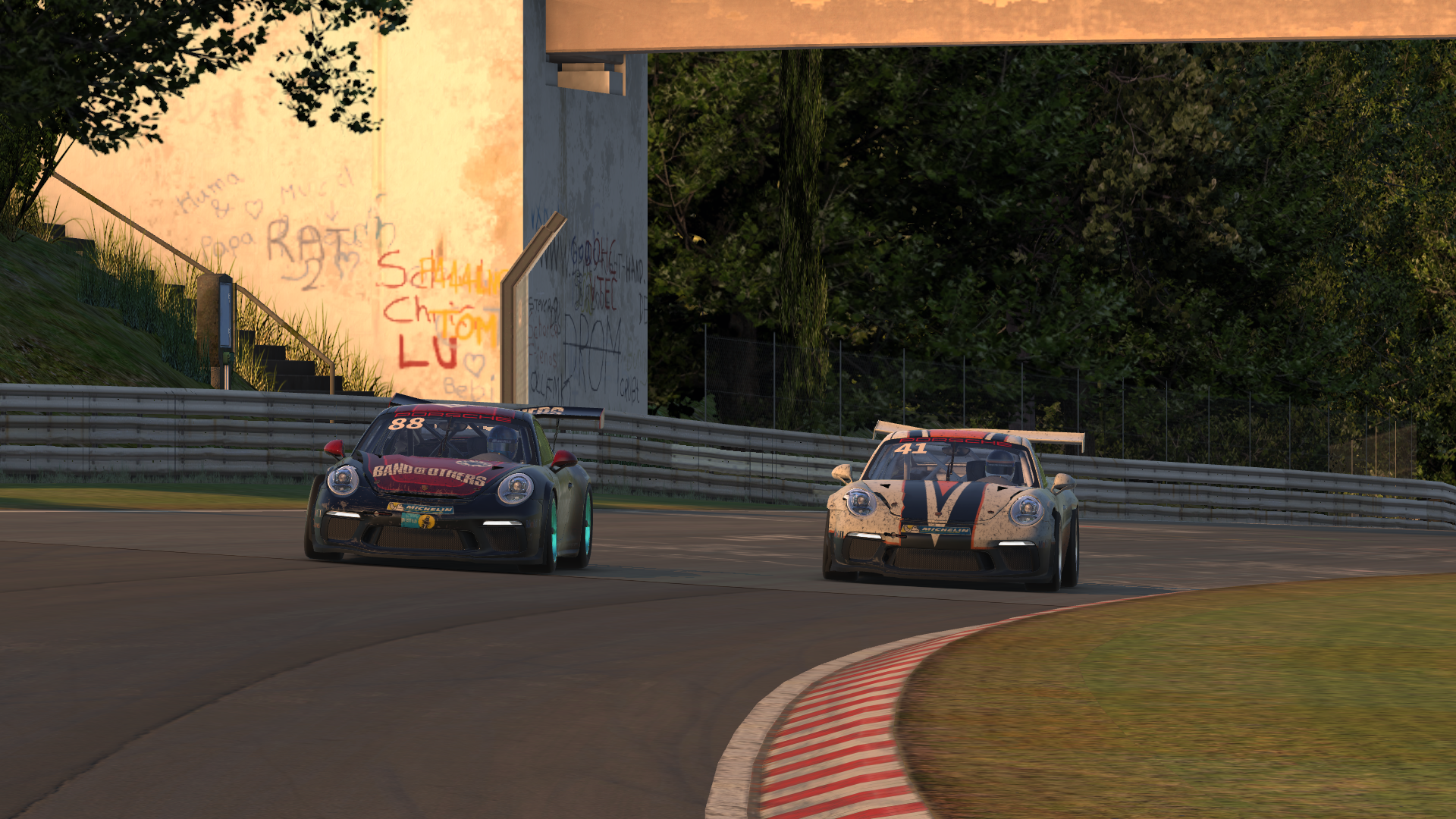
Making the pass for third place.
A few hours later, we moved up to second place as one of the cars ahead was crashed by a GT3 car — a roulette-like aspect of this race that adds to its punishing nature. We would need some similar luck to catch the leader, as they had a nearly spotless car and solid pace. All in all, they were running a clean race reminiscent of Karl’s and mine two years ago.
One luxury this year’s race afforded me that I hadn’t had in my win with Karl was rest. In that race, I had to settle for laying down to close my eyes — but never falling asleep — when he was in the car. This year, I got more than 7 hours of sleep as my four other teammates took turns behind the wheel.
Morning Rush
When I woke up, I found that we remained in second place but our car had a bit more front-end damage due to a real-life brake failure for one of our overnight drivers. We were down a few more miles per hour of top speed, but the car was still driving fine.
As I got in for my three-hour stint to close the race, I was awake and alert. Instead of feeling my eyelids get heavy and backing down my pace as I had near the end of the race two years ago, I was able to focus and push hard — at least as hard as I safely could.
Adjusting once again to the slower straight-line speed took a few laps, but as my fuel load burned off and I became even more comfortable around the track, I was able to push my pace lower and lower.
My best lap in those final stints — an 8:30.962 — was just seven tenths of a second slower than Steve’s fastest lap a few hours earlier. I usually feel lucky to be within a half-second of Steve at a normal track, so to be within a second of him at the behemoth Nordschleife was a solid achievement.
Although the traffic had thinned out during the grueling race, passing the much slower MX-5s was still challenging, and it made that extra sleep I’d gotten even more important. In the final hour, I closed in on a Mazda through the Stefan Bellof S section. He changed his line right as I got to his bumper, which forced me to hit the brakes, steer to the right, and four-wheel drift past the slower car.
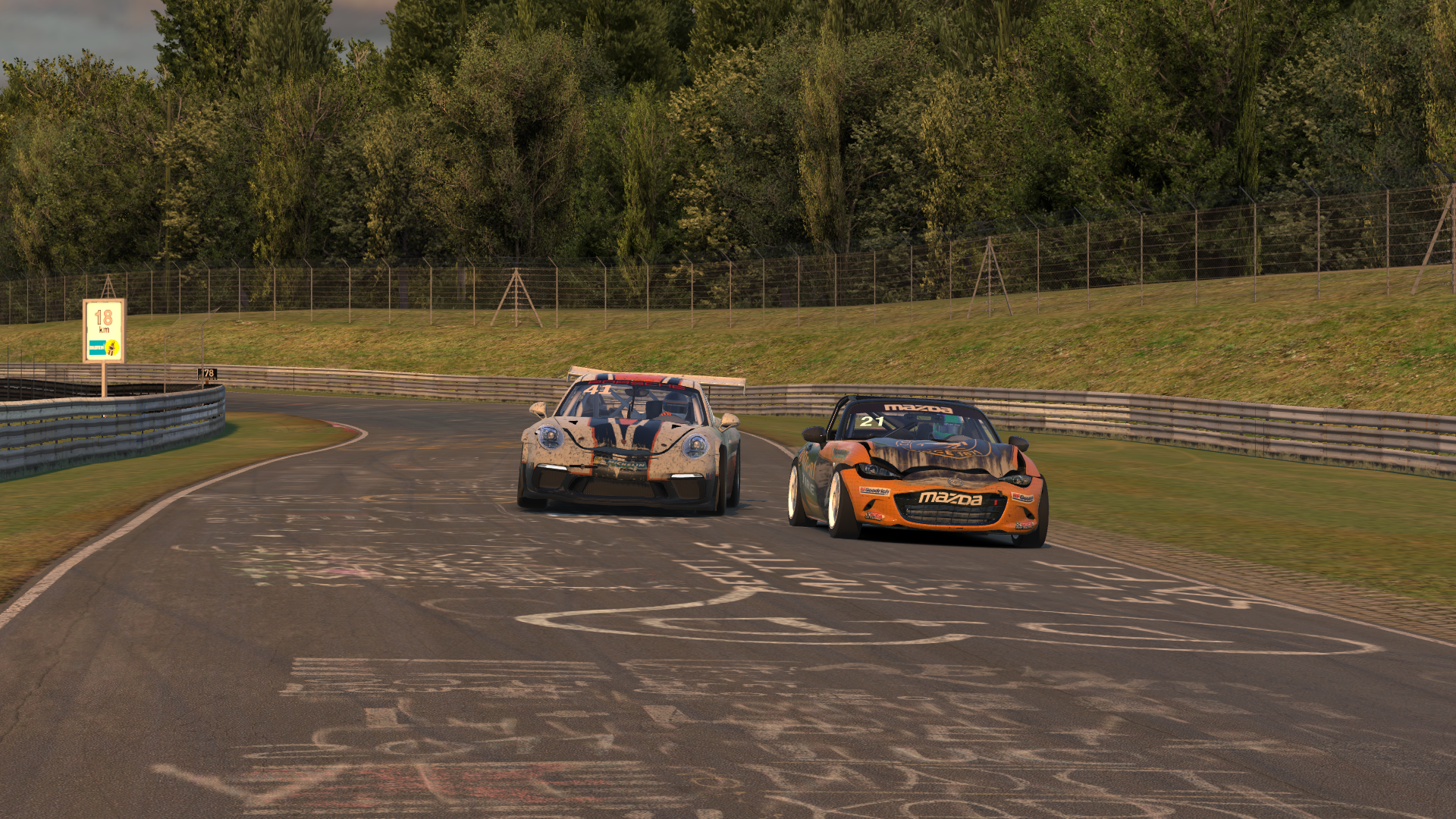
Narrowly avoiding an incident with an MX-5.
Approaching what I expected to be my final pit stop, I had to do some in-car fuel calculations on the track’s few long straightaways. With 70 minutes to go — the length of a full fuel run — I had two laps of fuel left, so I expected that my final stint would be at least one lap short of a full stint. I added enough fuel for seven laps instead of eight and set off on the run to the finish.
Little did I know that the perfect ingredients were brewing to screw up an otherwise sound fuel strategy. We were one of the farthest cars behind the overall leader in the closing laps, and they took the white flag with just a few seconds left on the clock before the 24-hour mark, which effectively lengthened our race by two laps. I only had enough fuel for one extra.
Maybe it was just bad luck, or maybe it’s another way the ‘Ring warps your sense of time. In any case, with two laps to go, I ducked into the pits for a splash.
Fortunately, our position was safe thanks to a nearly half-lap lead over third place.
At least as long as I didn’t make an even bigger error.
Frantic Final Laps
I was still pushing hard at pit entry, and it ended up being a bit too hard. I didn’t slow down soon enough and copped a 15-second speeding penalty, which was enforced after my fuel service. It was an uncharacteristic mistake that I’ve made less than a handful of times in race situations since I’ve been on iRacing.
But it wasn’t over. That mistake soon snowballed into another. Exiting the pits, I unwittingly sped again. I faced another 15-second penalty, which I had to serve the next lap when the white flag finally flew.
We still finished in second place, but those three mistakes — the fuel miscalculation and two speeding penalties — cost us at least a minute. I can only imagine how horrible I would have felt if that had cost us a position, or even worse, if the distraction had caused a crash.
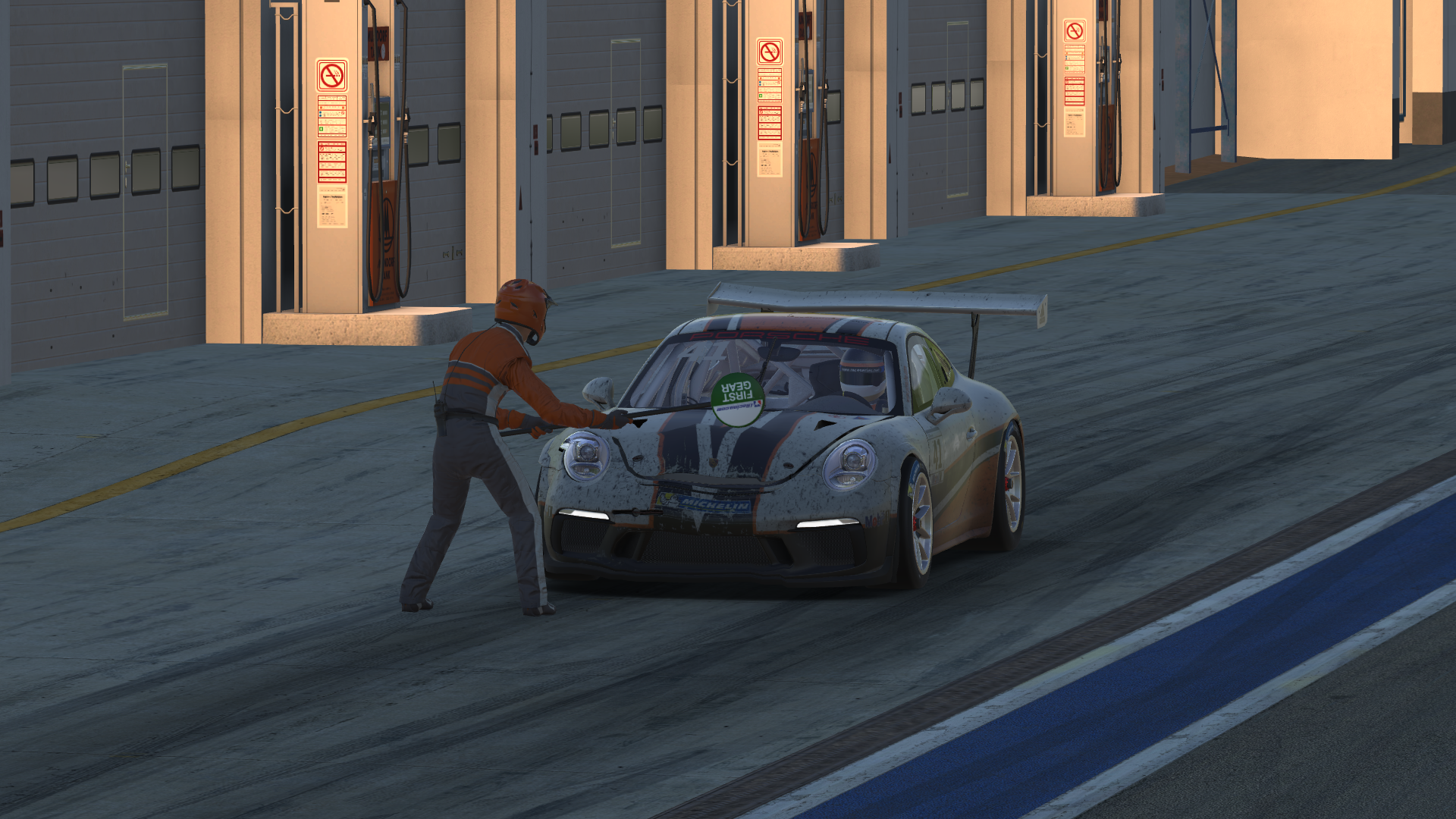
In the penalty box with one lap to go.
Despite those mistakes, I was more focused on the positives from the race. First and foremost, we made it to the finish, which only about half the teams in our split had done. We also fought hard all race to recover from — and eventually, live with — the damage, and we ended up on the podium. And while we all had a stumble or two along the way, none of them was too costly.
Bringing a damaged car home in second place with two speeding tickets and a faulty fuel calculation might not have given me the same sense of accomplishment as winning did, I think I came away from this year’s Nurburgring 24 Hours feeling much more confident in my own driving.
Instead of purposefully slowing down in my final stints just to keep the car on track in my zombie-like daze, I was able to push the car near its — or at least my own — limits with my eyes wide open, and I had the pace to show for it.
I still can’t claim I’ve mastered this track — can anyone? — and I’m sure there is time to be gained in some spots, but in this race, I was able to navigate the Nordschleife more quickly and more confidently than ever.
It seems the only section where I need some major improvement is, ironically, the slowest, straightest, and easiest part of the track.
Of course, that’s the pit lane.